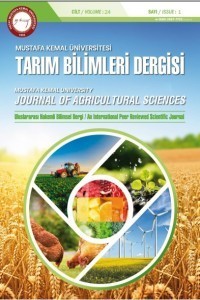Türkiye’de Botrytis cinerea ile enfekteli üzümlerde ikincil fungal hastalık etmeni Trichothecium roseum’un moleküler ve morofolojik olarak tanımlanması
Amaç: Türkiye’de bağ alanlarında Trichothecium roseum’un ilk kez teşhis edilmesi.Yöntem ve Bulgular: 2020 yaz ayları boyunca, hem bahçede hem de hasat edilen üzümler üzerinde beyazdan açık pembe renge kadar değişen renklenmeler gözlemlenmiştir. Üzümler üzerinde külleme belirtilerini andıran bu lekelenmelerin genellikle Botrytis cinerea’nın neden olduğu kurşuni küfle birlikte bulunduğu tespit edilmiştir. Hastalığın nedenini tespit etmek amacıyla Hassa ilçesine bağlı üzüm yetiştirilen alanlardan hastalıklı asma bitkilerine ait organlar toplanarak laboratuvara getirilmiştir. İzolasyonda iki farklı yöntem kullanılmış ve ayrıca ITS rDNA gene bölgeleri ITS1 ve ITS4 primer çifti ile çoğaltılarak sekans analizi yapılmıştır. Spor süspansiyonu yaprak, meyve, sürgün gibi bağ organlarına püskürtülerek patojenisite gerçekleştirilmiştir. Patojenisite testinden 7 gün sonra oluşan belirtiler bahçe şartlarında oluşanlarla aynı olduğu gözlemlenmiştir. ITS1/4 çifti ile çoğaltılan gen bölgesinden 700 bazlık bir dizi üretilmiş ve blast analizi gerçekleştirilerek Trichothecium roseum izolatına %99 oranında benzer bulunmuştur. Morfolojik ve moleküler özelliklerine göre, elde edilen fungus Trichothecium roseum olarak teşhis edilmiş ve bu fungus Türkiye’de bağlar üzerinde ilk kez bu çalışma ile tespit edilmiştir.Genel Yorum: Türkiye’de bağ alanlarında Trichothecium roseum bulunmakta ve Hassa ilçesine ait yetiştiricilik alanlarındaki Trichothecium roseum’un yoğunluğu ya da yaygınlığı bakımından bir farklılık bulunmamaktadır.Çalışmanın Önemi ve Etkisi: Trichothecium roseum Türkiye’de bağlar üzerinde ilk kez bu çalışma ile tespit edilmiştir. Bu fungus ekonomik olarak önemli kayıplar meydana getirmemekte ancak ürettiği mikotoksinler sebebiyle hem ekonomik hem de sağlık sorunlarına yol açmaktadır.
Anahtar Kelimeler:
Trichothecium roseum, üzüm, bağ, mikotoksin, pembe çürüklük
Molecular and morphological identification of fungal disease agent Trichothecium roseum developing secondarily to gray rot caused by Botrytis cinerea isolated from grapes in Turkey
Aims: Identification of Trichothecium roseum infecting grapes first time in Turkey.Methods and Results: During the summer of 2020, white and pale pink stains were observed on grapes in the vineyards and on the harvested grapes in storages. These stains resembling powdery mildew on the grapes were observed on the clusters, mostly developing secondarily to gray rot caused by Botrytis cinerea. To determine of the causal agent of disease symptoms, some symptomatic clusters were collected both from the vineyards and storages located in Hassa district of Hatay province in Turkey. Two different methods were used to isolate the fungus from the symptomatic tissues. For molecular identification, ITS rDNA gene sequence were amplified using ITS1 and ITS4 primers. Spore suspension of the fungus was sprayed on detached vine organs such as leaf, bud, stem and cluster, and after 7 days diseases symptoms were observed resembling those in the orchard. ITS1/4 primer pairs produced about 700 bp band on the agarose gel. Based on the morphologic and molecular characteristics, the fungus was identified as Trichothecium roseum and it has been identified for the first time on grapes in Turkey with this study.Conclusions: Trichothecium roseum is present on grapes in Turkey and there is no difference in the incidence or prevalence of Trichothecium roseum in the vineyards in the cultivation areas of Hassa district of Turkey.Significance and Impact of the Study: Trichothecium roseum was detected for the first time on vineyards in Turkey with this study. This fungus does not cause significant economic damage directly, but it causes both economic and health problems due to the mycotoxins which are produced by the fungus.
Keywords:
Trichothecium roseum, grapes, vine, mycotoxin, pink rot,
___
- Batt CA, Tortorello M (2014) Encyclopedia of food microbiology (2 ed.). London: Elsevier Ltd. p. 1014. ISBN 978-0-12-384730-0.
- Dal Bello G (2008) First report of Trichothecium roseum causing postharvest fruit rot of tomato in Argentina. Australasian Plant Disease Notes, 2008, 3, 103-104.
- FAO (2020) Food and Agriculture Organization of the United Nations, Rome, Italy Web. http:// www.fao.org/faostat/en/#data/QC.
- Han KS, Lee SC, Lee JS and Soh JW (2012) First Report of Pink Mold Rot on Tomato Fruit Caused by Trichothecium roseum in Korea. Res. Plant Dis. 18(4) : 396−398 (2012).
- Howard RJ, Garland JA, Seaman WL (1994) Identification of Acremonium acutatum and Trichothecium roseum isolated from Grape with White Stain Symptom in Korea. Mycobiology 2014 September, 42(3): 269-273.
- Lee Y, Kim GG, Chung YR (2005) Identification of Hanseniaspora (Kloeckera) sp. related with white dusty symptom of the grape. Res Plant Dis. 11:198-200.
- Li YB, Zhang ZP, Luo LX, Li JQ and Hao JJ (2020) First Report of Trichothecium roseum Causing Pink Fruit Rot of Prunus davidiana in China. 104 (9):2520.
- Oh SY, Nam KW and Yoon DH (2014) Identification of Acremonium acutatum and Trichothecium roseum isolated from Grape with White Stain Symptom in Korea. Mycobiology 42(3): 269-273.
- Onions AHS, Allsopp D, Eggins HOW (1981). Smith's introduction to industrial mycology (7th ed.). London, UK: Arnold. ISBN 978-0-7131-2811-6.
- Park JH, Han KS, Lee JS, Jang HI, Yiem MS (2004) Causal reason and control measures of ‘Campbell Early’ grape. Korean J Hortic Sci Technol 2004;22(Suppl 1):84.
- Staats M, Van Baarlen P, Van Kan JA (2005) Molecular phylogeny of the plant pathogenic genus Botrytis and evolution of host specificity. Mol Biol Evol 22:333-46
- Sutton B C (1980) The coelomycetes. Fungi with pycnidia, acervuli and stromata. Commonwealth Mycological Institute, Kew, Surrey, United Kingdom.
- Yayın Aralığı: Yılda 3 Sayı
- Başlangıç: 1996
- Yayıncı: Hatay Mustafa Kemal Üniversitesi
Sayıdaki Diğer Makaleler
Mehmet YALÇIN, Kerim Mesut ÇİMRİN
Sadık AKGÜL, Mona GAZEL, Bahar TUNÇ, Kadriye ÇAĞLAYAN
Mehmet İlhan ODABAŞIOĞLU, Sadettin GÜRSÖZ
Ahmet Erhan ÖZDEMİR, Tuğba ATABEY
Muğla-Ula yöresinde Vitex agnus-castus L. (Verbenaceae) fenolik bileşenlerinin belirlenmesi
Antakya’da taşkına neden olan yan derelerde hidrograf analizi ile taşkın tahmini
